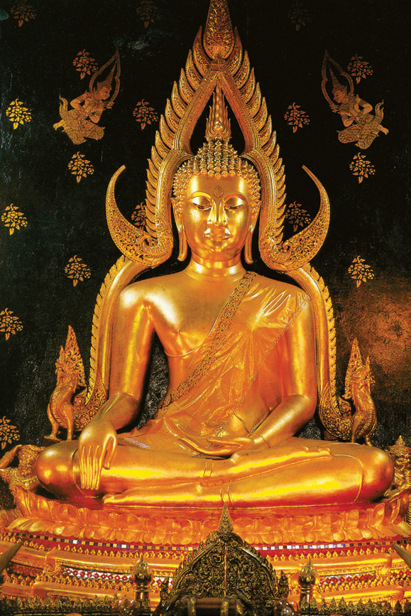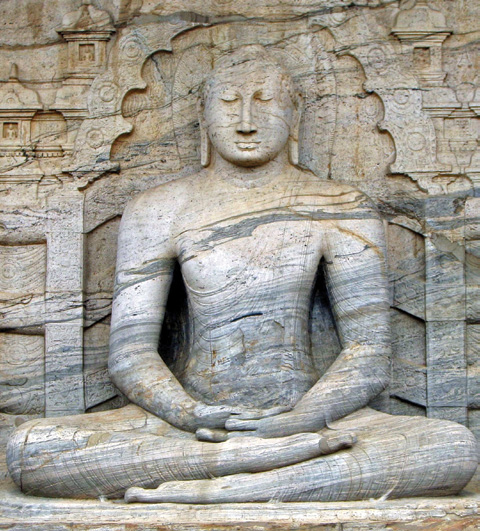An Illustrated Outline of Buddhism: The Essentials of Buddhist Spirituality (17 page)
Read An Illustrated Outline of Buddhism: The Essentials of Buddhist Spirituality Online
Authors: William Stoddart,Joseph A. Fitzgerald
Tags: #Philosophy



48
An Illustrated Outline of Buddhism
The most elementary religious viewpoint envisages two funda-
mental realities, namely God and man or Creator and created. In Bud-
dhism, the corresponding pair would be
Nirvāna
and
samsāra
.
Within
each of these two realities, however, a distinction can be made. As re-
gards man, it is clear that man consists of body and soul (pertaining
respectively to the corporeal realm and the subtle or psychic realm). As
regards God (or the Nirvanic Reality), the distinction to be made, ac-
cording to the metaphysicians and mystical theologians of all the great
religions, is as follows:
(1) The Divine Essence (the level of “Beyond-Being”)
—the “Supra-Personal” God.
(2) God as Creator, Sustainer, and Judge (the level of “Being”)
—the “Personal” God.
Thus we reach four levels of reality: two human and two divine.
Most importantly, there is, between the two Divine and the two purely
human levels, the level of what the Ancient and Medieval philosophers
and theologians called the Spirit (
Spiritus
or
Pneuma
)
or Intellect (
Intel ectus
or
Nous
).
The Spirit or Intellect (in Sanskrit,
Buddhi
),
although “created”, is supra-formal and “universal”. It is directly touched
by the “Nirvanic” or the Divine. The soul, on the other hand, is formal
and “individual”. Pertaining to the Intellect are such things as our con-
science and our sense of justice. Above al , the Intellect is the faculty
which enables man to conceive the Absolute, and to know the Truth.
It is the source of his capacity for objectivity, of his ability—in contra-
distinction from the animals—to free himself from imprisonment in
subjectivity. It is the very definition of the human state.
The term “Intellect” must not be confused with “mind” (faculty of
discursive reason) which, along with imagination, memory, sentiment,
and wil , is one of the contents of the soul (
anima
or
psyche
).
The Spirit or Intellect belongs to the “angelic” realm, the realm of
the Platonic archetypes. It supplies the only “archetypal” or objective
element in the constitution of man. The Intellect is thus the “measure”
of the soul; the soul can never be the “measure” of the Intellect. Spirit
and Intellect are the two sides of the same coin, the latter pertaining to
Truth (or doctrine) and the former to Being (or realization).



The Nature and the Teachings of Buddhism
49
Rock-cut statue of the Buddha,
Gal Vihara, Polonnaruwa, Sri Lanka, 11th century

50
An Illustrated Outline of Buddhism
It is perhaps worth mentioning in passing that the fatal error of
the modern psychologists (notably Jung) is their hopeless confusion of
Spirit and soul, which in practice amounts to the “abolition” of Spirit.
This is the “abolition” of the Absolute—and the objective—with a ven-
geance, and it has had disastrous consequences for religion and spiri-
tuality.
Without the concept—and the reality—of the Spirit or Intellect,
no contact whatsoever between God and man would be possible. This
indeed seems to be the position of the Deists. The Spirit or Intellect in
fact corresponds to the
created Logos
, while God as “Being” is the
un-
created Logos
. It is thus that the
Logos
, with its two “Faces” (created and
uncreated), constitutes the “bridge” between man and God.
The uncreated
Logos
is the prefiguration of the relative in the Ab-
solute (this is God as Creator) and the created
Logos
is the reflection
of the Absolute in the relative (this is, on the one hand, Truth and Vir-
tue, Symbol and Sacrament; and, on the other,
Avatāra
,
Tathāgata
,
Redeemer, or Prophet).
In Buddhism, these five levels of reality appear in the form of the three
“hypostases” or “bodies” (
trikāya
)
of the Buddha. These are as follows:
(1) Divine Essence “Beyond-Being”
D
harmakāy
a
“universal body”
(2) Personal God
“Being”
(uncreated
Logos
)
Sambhogakāya
“body of felicity”
(3) Spirit or Intellect SPIRITUS,
(
Logos
)
(created
Logos
) INTELLECTUS
(4) soul
ANIMA
Nirmānakāya
“body of
(5) body
CORPUS
permanence”


The Nature and the Teachings of Buddhism
51
Level (1), “Beyond-Being” or the Divine Essence, is the Absolute.
Level (2), “Being” or the Personal God, is the first autodetermination
of the Absolute and the beginning of relativity. In Hindu terms, this is
the distinction between
Ātmā
and
Māyā
.
Levels (3), (4), and (5) taken together constitute creation, existence, or manifestation.
In the metaphysical terminology of René Guénon, one can say
that, macrocosmical y, level (3) is “supra-formal manifestation” (the
Paradisal or angelic realm). Levels (2) and (3) taken together have been
called “higher
Māyā
”.
There is an intimation of “higher
Māyā
” in the world seen as theophany.
Macrocosmical y, levels (4) and (5) taken together constitute “for-
mal manifestation” (the “world” or
samsāra
).
This is “lower
māyā
”—
the world as exile and separation from God.
Although, metaphysical y, “lower
māyā
” (
samsāra
)
is il usion, at
the human or moral level, it is the source of temptation, and is power-
ful y ensnaring; it is notoriously unwilling to release those whom it